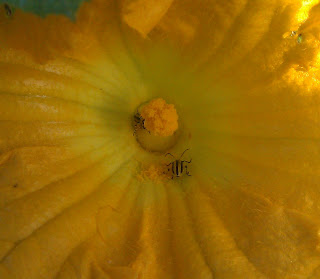This week has been all about
cherries...
(Jim helping out the gardening team - with a little help from Blue)
The sour cherries came in a
little early, and have come in abundance with almost 80 pounds picked so
far. We are currently about halfway
through on just the first pick, so there are a lot more to go. We had the
Rappahanock high school horticulture class out for a tour and they helped us
pick for an hour, and this morning the folks from the kitchen were out in the
trees as well. All the delicious fruit
is then brought in, pitted and made into amazing tarts and pies. Lots of work
for all involved but well worth it.
It was great to have the kids out
yesterday, seeing teenagers interested in gardening/farming always makes me
happy. There are many factors
contributing to the decline in agriculture in America
As I was spraying fish fertilizer at 5:30 am (after working till almost 8 the night before) it occurred to me (as it has many times) how much dedication and passion it takes to run even a small farm successfully. Plants always need something; water, fertilizer, or help with the pests and weeds, they never take the day off. It could be100 degrees or cold and raining but the “to do” list is never finished. That being said, I do take the occasional afternoon to myself, and of course I have the winter months to relax and recharge, you have to find balance where you can. Agriculture is not a career choice, it is a lifestyle choice, and there are great benefits to be found as well. You get to be outside playing in the dirt all day (and at least inVirginia
As I was spraying fish fertilizer at 5:30 am (after working till almost 8 the night before) it occurred to me (as it has many times) how much dedication and passion it takes to run even a small farm successfully. Plants always need something; water, fertilizer, or help with the pests and weeds, they never take the day off. It could be100 degrees or cold and raining but the “to do” list is never finished. That being said, I do take the occasional afternoon to myself, and of course I have the winter months to relax and recharge, you have to find balance where you can. Agriculture is not a career choice, it is a lifestyle choice, and there are great benefits to be found as well. You get to be outside playing in the dirt all day (and at least in
So, this week, besides all the
cherry picking, we have also planted watermelons, winter squash, gourds and
more cutting flowers. I pruned and trellised all of the tomatoes. The rainbow
carrots, salsify and scorzonera have popped up, and the fava bean pods are
finally forming. We are harvesting the last of the pac choi and radishes, as
well as turnips, strawberries, peas, beets, broccoli, fennel, kohlrabi, frisee,
lettuce, swiss chard, summer squash, squash blossoms and herbs. Next week will
be more hot weather and of course more cherries!!!

















